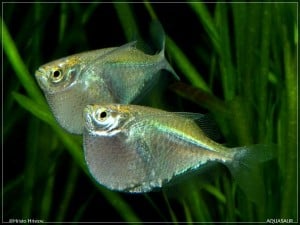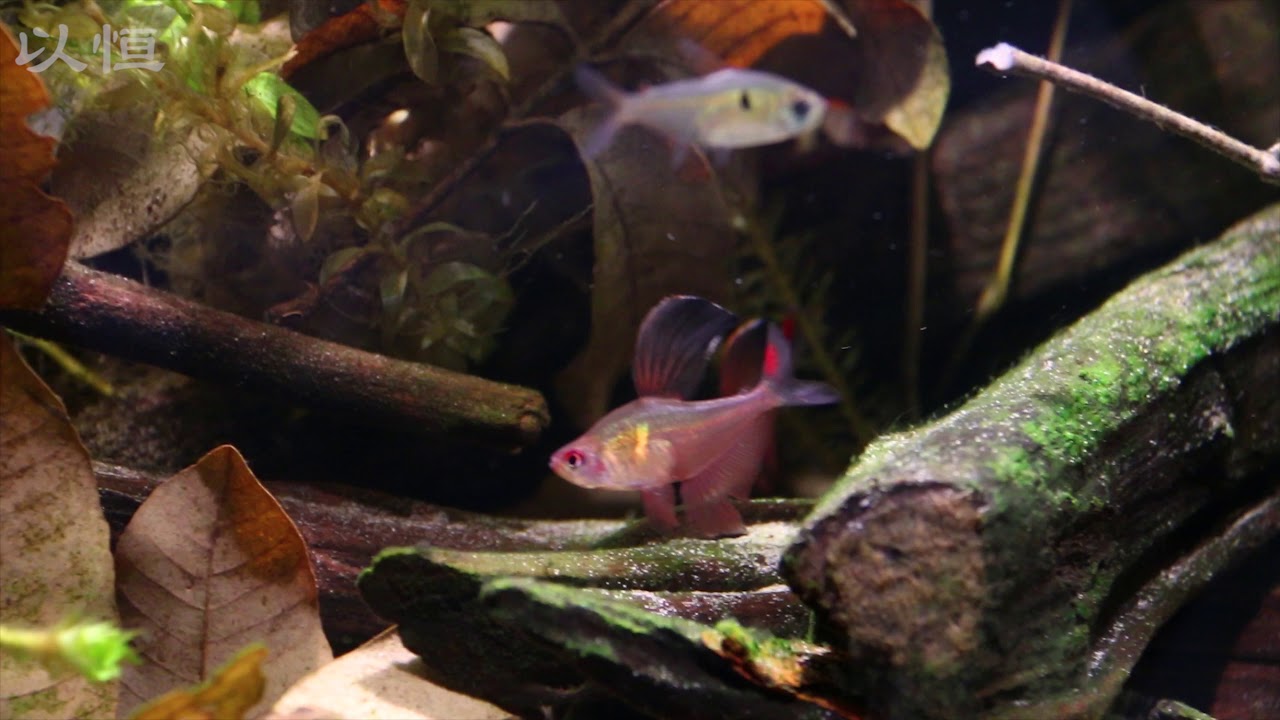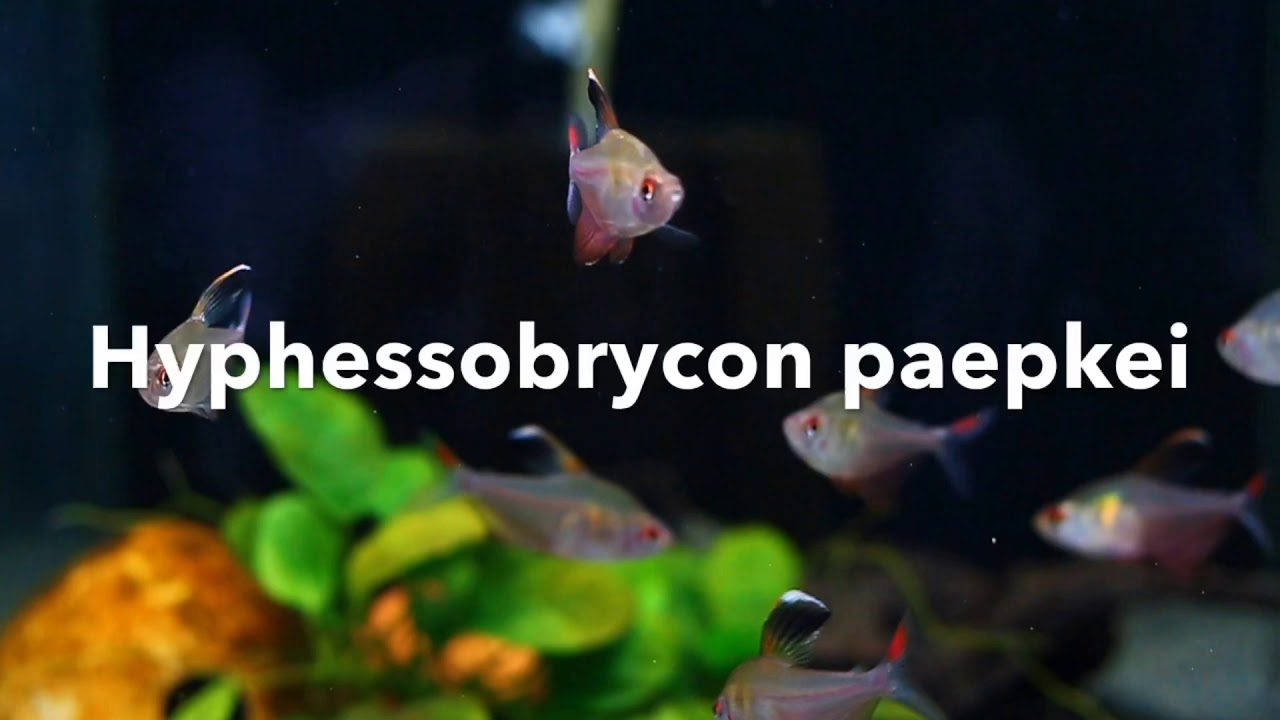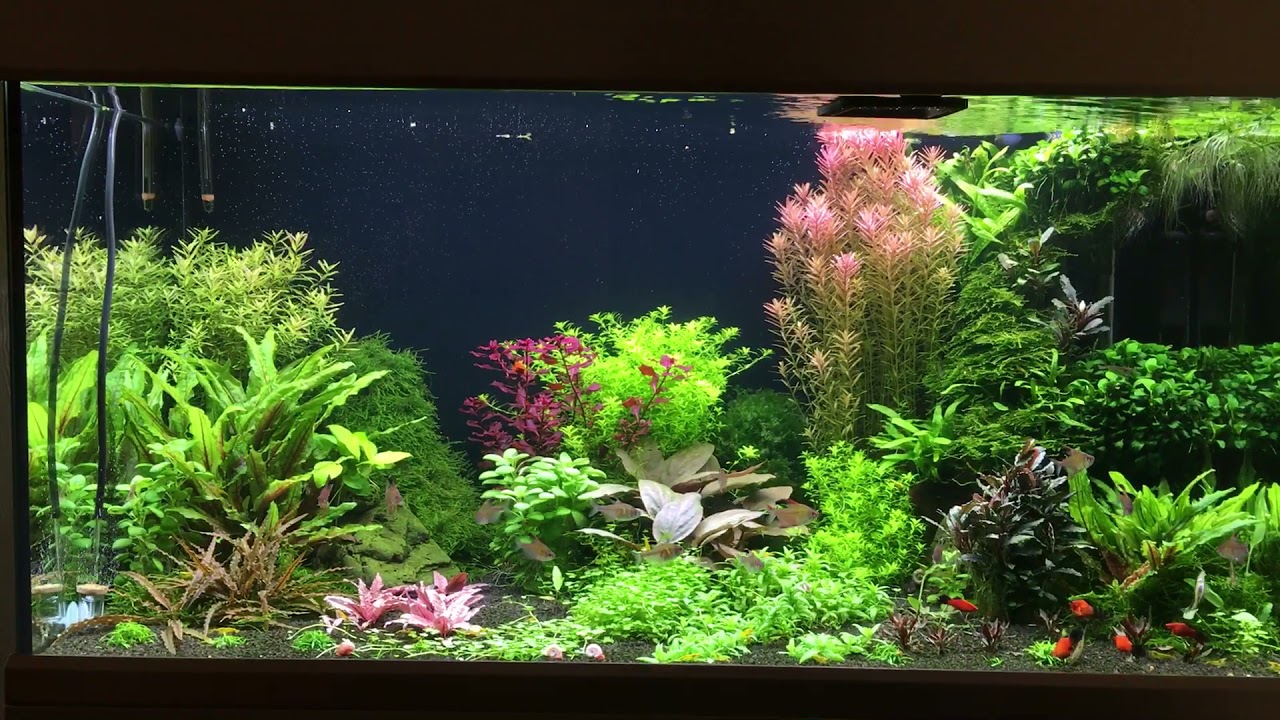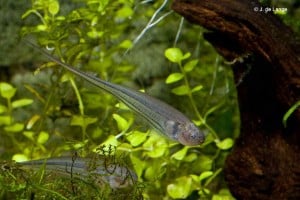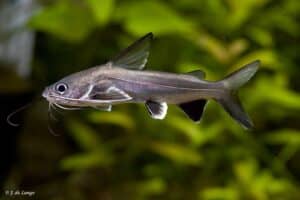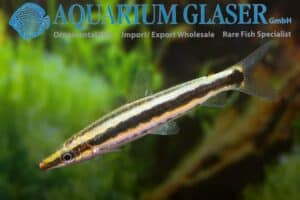Hyphessobrycon paepkei – Goldshoulder Rosy Tetra
Hyphessobrycon paepkei was first described scientifically by Axel Zarske in 2014. They belong to the family Acestrorhamphidae, the American Tetras. Their common name is Gold Shoulder Rosy Tetra.
The meaning of the genus name Hyphessobrycon is somewhat uncertain. The second part, “-brycon,” is derived from the Greek word βρύκω (brykō), meaning “to bite.” The first part, “Hyphess-“, would possibly be a misspelling of the Greek υπελάσσων (hypelassōn), meaning “slightly smaller.” The species name paepkei is a tribute to Dr. Hans-Joachim Paepke, an ichthyologist at the Museum für Naturkunde in Berlin.

Description
The Goldshoulder Rosy Tetra has a stretched but somewhat stocky body that is flattened laterally. The head and flanks show a light, beige to silver-blue ground color. A prominent feature is the golden shoulder stripe, to which the Dutch name refers. The back is often slightly darker than the ventral region. Some specimens show a slightly checkered pattern on the upper rows of scales, formed by a concentration of chromatophores (color cells) on the back of the scales. The fins are translucent to yellowish, sometimes with red highlights. The dorsal fin sometimes has a white spot on the tip. The maximum total length is about 3.5 to 4 centimeters.
Differences between males and females
Males are generally larger and slimmer than females. They have longer flared dorsal and anal fins, which have a more pointed shape, especially at the anal fin. Colors are more intense in males than in females. Behavioral differences between the sexes are not known, but males may exhibit fin-flaring (flaring of the fins) during rivalry. Young fish soon have the same shape as adults but are less brightly colored.
Behavior and temperament
Hyphessobrycon paepkei is a peaceful shoal fish. They prefer to live in groups of six or more individuals. They are not shy and swim in the middle waters of the aquarium, often near plantings. They are not aggressive toward other peaceful fish species, but it is advisable not to keep aggressive or much larger fish in the same aquarium.
Life expectancy
The life expectancy of Hyphessobrycon paepkei in the wild is unknown. In an aquarium they can live up to about 3 to 5 years old.
Hyphessobrycon paepkei Biotope
Hyphessobrycon paepkei is found in the wild in Brazil. Its specific location within Brazil is the Rio Demini basin, a tributary of the Rio Negro in the Amazon Basin. They are river fish that live in the small, clear tributaries and streams of the Amazon Basin.
Natural habitat
Their natural habitat is characterized by soft, slightly acidic waters and a dense cover of aquatic plants. The banks of these waters are probably covered with trees and other vegetation, typical of the Amazon rainforest. The bottom probably consists of sand or a mixture of sand and organic material.
Climate
The Goldshoulder Rosy Tetra lives in a tropical climate with constant temperature and high humidity. The Amazon basin has seasonal variations in water levels, with periods of floods and droughts.

Diet
Diet in the wild
The exact composition of the diet of Hyphessobrycon paepkei in the wild is not fully documented. Considering their habitat and the general feeding habits of related species within the genus Hyphessobrycon, we can assume that they feed on a variety of small invertebrates, such as insect larvae (such as mosquito larvae), small crustaceans (such as water bugs and water fleas), and other small organisms found in the water . They probably also ingest small amounts of plant material.
Diet in the aquarium
In the aqu arium, it is important to feed Hyphessobrycon paepkei a varied diet to maintain their health and vibrancy. They accept a wide range of foods, including:
- Dry food: High quality flake food, micropellets and pellets are a good basis for their diet. Choose dry food specifically designed for small, omnivorous fish.
- Live food: Small amounts of live food, such as fruit fly larvae (Drosophila), microworms, artemia and Daphnia, are a valuable addition to their diet and provide additional stimulation.
- Frozen food: Frozen food, such as mosquito larvae, Artemia and cyclops, can also be offered. Be sure to offer the food in small pieces, adapted to the small mouth of this fish.
It is important to give the food in small portions so that it is completely eaten within a few minutes. Overfeeding should be avoided as it can lead to water pollution. A varied diet ensures optimal health and vibrant colors in these fish.
The Aquarium
For a small group of 6 to 8 Hyphessobrycon paepkei, an aquarium of at least 60 centimeters in length (about 80 liters) is suitable. If you want to keep a larger group, you should increase the aquarium size proportionally. A larger group of fish will provide a more natural shoaling behavior and less stress for the individual fish.
Furnishings should mimic the fish’s natural habitat. A dense planting of fine-leaved plants, such as Java moss, is essential. These plants provide hiding places and provide a sense of security. A dark bottom, for example of sand or dark gravel, enhances the colors of the fish. A light current in the water is also recommended. The addition of oak or beech leaves can help create a more acidic environment and brown water color, mimicking the natural habitat.
The ideal water conditions for Hyphessobrycon paepkei are soft to moderately hard water with a pH of 5.5 to 7.5 and a temperature between 22 and 28°C .
Hyphessobrycon paepkei is a peaceful fish that lives well with other small, peaceful species . Suitable tankmates include Corydoras armored catfish, small species of barbs, rasboras, small loricariids, some species of anabantoids and small West African dwarf cichlids . Avoid larger, aggressive fish or species with long fins, which may stress or injure Hyphessobrycon paepkei.
A well-designed aquarium with appropriate water values and compatible tankmates is essential for the well-being of Goldshoulder Rosy Tetra. Mimicking their natural environment is crucial to their health and vibrancy.

Breeding Aquarium and Conditioning
For breeding Hyphessobrycon paepkei, a separate breeding aquarium is recommended. The size of this aquarium depends on the number of breeding pairs, but an aquarium of about 20-40 liters is a good start. The aquarium should be darker than a regular aquarium to reduce stress on the fish. The eggs are also light sensitive! Water quality should be identical to that of the main aquarium: soft to moderately hard water (GH 1-12), slightly acidic (pH 5.5-7.5) and a temperature of 23-27°C. A small, quiet sponge filter is sufficient to maintain water quality. Lighting should be dimmed.
Conditioning:
Before the fish are introduced into the breeding aquarium, it is important to condition them. This involves offering them extra nutritious food, such as live or frozen food (microworms, artemia, small daphnia) for several weeks. This stimulates reproduction.
There are two possible breeding methods
Group breeding: A group of several males and females (e.g. 2-3 males and 3-4 females) are placed together in the breeding aquarium. The ratio of males to females is important here to limit competition between males.
Pair breeding: A single breeding pair is placed in the breeding aquarium. This requires careful selection of a healthy male and female.
The Spawn
During spawning, the colors of the fish become more intense. Males show their most vivid colors, with an enhancement of the golden shoulder stripe and possibly more red highlights in the fins. Females show a fuller, rounder body as a result of the mature eggs.
Courting probably involves a combination of chasing, fin-flaring ( fanning the fins ) by the males and displaying specific movements and body positions.
The eggs are deposited on fine-leaved plants, such as Java moss, or on other suitable substrates in the breeding aquarium. A depositing mop can also be used. Mating usually takes place in the morning or early afternoon. The parents do not guard the eggs and often eat them. It is therefore essential to remove the parents from the breeding aquarium after laying.
The number of eggs per clutch is variable, but can reach several hundred. The eggs are small, translucent and have a pale yellow color.
Raising Young Hyphessobrycon paepkei
The eggs hatch after about 24 to 36 hours. The larvae become free-swimming after about 5 days. In Hyphessobrycon paepkei, there is no parental care.
The first food for young fish consists of infusoria or nauplii of artemia (brine shrimp). Very fine, specially designed for young fish, dry food can also be used. Regular small water changes (e.g. 20-30% per week) are important to maintain water quality.
The percentage of surviving juveniles is variable and depends on several factors, such as water quality, nutrition and the amount of young fish packed together. A high survival rate requires optimal conditions and careful care.

Conclusion
The Goldshoulder Rosy Tetra is a relatively new species in the aquarium hobby, so information is still scarce. Based on available data , it appears to be a relatively easy fish for beginners, provided the specific water parameters (soft, slightly acidic water) are met and they are kept in a group of at least six specimens. A well planted aquarium with sufficient hiding places is essential for their well-being.
A notable feature is the golden shoulder stripe and the variation in color intensity between males and females. It is a peaceful schooling fish, suitable for a community aquarium with other small, peaceful species. More research on their behavior and breeding in captivity is desirable to get an even more complete picture of this fascinating fish.
Video
Author
John de Lange
Copyright images





